So way back in June I mentioned I was working on illustrating this Nietszche quote: “Wer mit Ungeheuern kämpft, mag zusehn, dass er nicht dabei zum Ungeheuer wird. Und wenn du lange in einen Abgrund blickst, blickt der Abgrund auch in dich hinein.” Or, in English, “He who fights with monsters might take care lest he thereby become a monster. And when you gaze long into an abyss the abyss also gazes into you.” That’s Aphorism 146 from “Beyond Good and Evil” if you’re curious.
That’s all well and good, but I only realized just now that I forgot to post the other 3 parts! I finished them months ago but at least it’s still 2014. For a couple more days, anyhow. Okay, one more day. But who’s counting.
This is the second half of that first sentence, “daß er nicht dabei zum Ungeheuer wird.” Everybody knows that the bird is the wird. Haha, just kidding with that last bit, just a multilingual pun there. I’m a Dad, I can’t help it.
“Und wenn du lange in einen Abgrund blickst…”
“…blickt der Abgrund auch in dich hinein”.
These are not the best photos in the entire world but I figured I should at least let you, dear reader, enter 2015 safe in the knowledge that I do actually finish my projects.
Time flies as always, and whaaddaya know, the holiday season is upon us once again! As in years past, I have made Christmas cards and sent them out to everyone on my mailing list… if you are not on my mailing list, enjoy this digital version!
However you spend your holidays, I hope that you enjoy them in good company, and have an excellent New Year.
Checking up on one of my favourite art blogs, Lines and Colors, I became acquainted with the work of Dina Brodsky. Intrigued, I started reading up on Brodsky and her work.
Born in 1981 in Minsk, Belarus, Brodsky moved to the United States with her family in 1991.
Dina Brodsky did not set out to be a painter. She graduated from high school and started college just before she turned 18, which gave her some time to kill. So she enrolled in a painting class.
“I didn’t know what I was doing with myself ,” Brodsky said in an interview with Fusion. “I thought painting would be an interesting thing to do until I turned 18, dropped out, and hitchhiked around Europe. That was my plan.”
Picking up a paintbrush for the first time was a transcendent experience for her — one that lead to what she calls her “improbable career” as a professional miniaturist.
Inside the impossibly small world of Dina Brodsky’s paintings, Jessica Roy November 23, 2014
So yeah, happy accidents. From her start at the Amsterdam Academy of the Arts, Brodsky went on to earn a BFA from University of Massachussetts (2004) and an MFA from the New York Academy of Art (2006) and has exhibited in at least one show every year since graduating.
There’s something very intriguing about miniature painting, especially within the context of representational realism. There’s the charm of the small, with its spatial intimacy. You can’t stand back and let a miniature painting wash over you. There is no monumental domination of your field of vision, only you, very close to a small work that is rendered in high detail. You have to get right in there with the art, examining the details. It occupies the same space as you do. But this is where it gets interesting: you are the only person. There are traces of people, and implied narrative, like the repeated appearance of the red, sleeveless summer dress. Sometimes there are birds, or small animals. Whether the birds & animals are meant symbolically or as a simple incursion of nature into previously occupied spaces is unexplained.
The physicality of the art is also intriguing, for a few reasons – first, many of them are round, which suggests the round windows that are often cut into the hoardings of a construction site where you can only really glimpse the work on the other side from a very specific angle, especially because they are unframed. By extension, the similarly unframed square paintings also become fixed windows; not the kind with casements and curtains, but a temporary peephole into another place. Of course this impression is also nudged along by Brodsky’s titles, like demolition Spyhole (a recurring series).
The second thing that is intriguing about the paintings in a physical sense is the media used – mostly oils on different plastics like Plexiglas or drafting mylar. Presumably this is so that the grain of canvas doesn’t interfere with the fine detail of the renderings, but paint behaves differently on plastic than it does on even slightly absorbent material.
It’s also interesting in that it is a non-traditional medium, at least for fine art – painting on plastic is more typical of animation cels. Not that there’s anything cartoonish about Brodsky’s work. I see it more as a kind of contemporary contextualization, reminding us that while we are looking at miniature painting, these are not the precious jewels of the Renaissance.
Dina Brodsky is currently exhibiting her work at Sirona Fine Art in a dual show with Wesley Wefford, titled “Miniature & Majestic”.
The show runs until January 11, 2015 so if you happen to be looking for something to do in or near Hallandale, Florida over the next couple of months, Sirona Fine Art is at 600 Silks Run #1240, The Village at Gulfstream Park, Hallandale Beach, Florida.
If you would like to see more of Brodsky’s work, you can check out her personal portfolio website, http://dinabrodsky.com/ or if you are down with the Book of Faces she has a page there,too –https://www.facebook.com/dina.brodsky.7.
All images used in this post are used with permission, courtesy of the artist.
The Wadsworth Atheneum is one of the oldest public art museums in the United States. Okay, they say the oldest but Wikipedia disagrees. I’m not here to fight it out, but rather to praise. The Wadsworth Atheneum has an impressive collection, it was the first in America to acquire pieces by Salvador Dalí, Balthus, & Piet Mondrian, and hosted the first American exhibition of surrealism in 1931. They also happen to have my personal favourite painting, Max Ernst’s masterpiece, “Europe After the Rain II”.
Early in 2015, a new exhibition will be on display in the newly expanded and renovated exhibition hall of the Wadsworth Atheneum, “Coney Island: Visions of an American Dreamland, 1861-2008”.
It’s based on a pretty interesting idea, which is using art to look at 150 years of Coney Island’s history from undeveloped beachfront to its present incarnation, and all the stages inbetween.
- William Merritt Chase, Landscape, near Coney Island, c. 1886, oil on panel
- Samuel S. Carr, Beach Scene, c. 1879, oil on canvas
The modern American mass-culture industry was born at Coney Island, and the constant novelty of the resort made it a seductively liberating subject for artists. What these artists saw from 1861 to 2008 at Coney Island and how they chose to portray it varied widely in style and mood over time, mirroring the aspirations and disappointments of the era and of the country. Taken together, these tableaux of wonder and menace, hope and despair, dreams and nightmares, become metaphors for the collective soul of a nation.
– from the exhibition’s website
Coney Island has a pretty fascinating history. Originally an undeveloped beachfront, it was a popular resort destination around the end of the American Civil War, with 3 elegant hotels by the early 1800s. By 1897 the amusement parks had already begun to spring up. By the time of the famous Dreamland fire in 1911, Steeplechase Park and Luna Park were well-ensconced. Coney Island became wildly popular with working-class New Yorkers looking for a way to beat the summer heat as the movement in the 1880s to have a “half-holiday” on Saturdays (until then, people worked 6 days a week) coincided with the expansion of excursion railroads and the Brooklyn street car line. At the time, there were few places for working class people to socialize, particularly women. Even before the subway line was expanded in 1915, Coney Island’s star was at its peak; when Dreamland, Steeplechase Park, and Luna Park were all open upwards of 100,000 people a day would visit.
- Reginald Marsh, Wooden Horses, 1936, tempera on board
- Reginald Marsh, Pip and Flip, 1932, tempera on paper
- Milton Avery, The Steeplechase, Coney Island, 1929, oil on canvas
Coney was at its peak during the years that the three major amusement parks dominated the scene. It was the major tourist destination in America. Crowds routinely topped 100,000. In contrast, Disney World has never reached this figure.
– the Ultimate History Project: “America’s Playground”, John Parascandola
After WWII, Coney Island became less popular for a variety of reasons, including the invention of home air conditioning. By the 50s it was notorious for gang problems and prostitution. Skip ahead a few years and Hurricane Sandy messed things up, but it’s been repaired, spiffed back up, and still going strong.
- Morris Engel, Coney Island Embrace, New York City, 1938, gelatin silver print
- Homer Page, Coney Island (Couple on Beach), c. 1949, gelatin silver print
- Little Fugitive, production still, 1953
“Coney Island” will feature more than 140 objects, comprised of both celebrated icons of American art and rarely-shown works from both public and private collections, including paintings, drawings, photographs, prints, posters, architectural artifacts and carousel animals. Ephemera, sound recordings and film clips will immerse visitors in the popular culture of Coney Island.
– from the exhibition’s press release
- Red Grooms, Weegee 1940, 1998–99, acrylic on paper
- Frederick Brosen, Astroland, 2008–13, watercolor over graphite on paper
- Arnold Mesches, Anomie 1991: Winged Victory, 1991, acrylic on canvas
One of the great things about me writing about this show 3 months in advance is that it gives you, dear reader, plenty of time to make travel plans. The Wadsworth Atheneum is located at 600 Main Street in Hartford, Connecticut, and the show runs from January 31 to May 31, 2015.
Should travelling to Connecticut be an issue, fear not – the exhibition will also travel to 3 other venues in the US: the San Diego Museum of Art, July 11, 2015 – Oct. 13, 2015; the Brooklyn Museum, Nov. 20, 2015 – March 13, 2016, and the McNay Art Museum in San Antonio, Texas, May 11, 2016 – Sept. 11, 2016.
For more information about “Coney Island: Visions of an American Dreamland, 1861-2008”, visit the Wadsworth Atheneum’s website. All images used in this article are courtesy the Wadsworth Atheneum and the works shown are part of “Coney Island: Visions of an American Dreamland, 1861-2008” exhibition.
As my regular readers know, I do some writing for Omen, the Montreal Street artist. Throughout the summer he’s been working on OMENfest, painting all over Montreal and other locations such as Toronto and Rochester.
He’s also been working on a project sponsored by Canon, part of their True Originals campaign.
You can read all about it on his blog but here’s a great video of Omen working in Montreal, doing a big mural down on Mont-Royal. Like I wrote on omen514.com,If you’ve never seen a mural artist at work using cans like a ninja, here’s your big chance! Just click on the preview image below and you will be whisked away to a magical land of slap bass and spraypaint.
Anyhow, for more news of Omen’s upcoming projects, go check out omen514.com. He’s a busy guy!
























